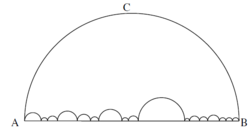Which Route Should I Take?
 When you travel from A to B, you can either travel along the big semi-circle (i.e. via C) or you can travel along all the smaller semi-circles. Which is the shorter route and why?
When you travel from A to B, you can either travel along the big semi-circle (i.e. via C) or you can travel along all the smaller semi-circles. Which is the shorter route and why?
Problem 5 on South African Mathematics Olympiad Junior Round 3 Paper 2012
This section requires Javascript.
You are seeing this because something didn't load right. We suggest you, (a) try
refreshing the page, (b) enabling javascript if it is disabled on your browser and,
finally, (c)
loading the
non-javascript version of this page
. We're sorry about the hassle.
The length of the path through C is half the circumference of the corresponding circle, i.e. 2 π × d .
The length of the path through the small semicircles is the sum of the individual lengths of each semicircle, i.e. 2 π × d 1 + 2 π × d 2 + 2 π × d 3 + . . . = 2 π × ( d 1 + d 2 + d 3 + . . . ) Also the diameter of the big semicircle is quite obviously equal to the sum of diameters of the smaller semicircles. So this length is also 2 π × d . The paths have equal length.